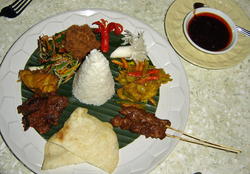 | |
| Alternative names | Nasi rames |
|---|---|
| Course | Main course |
| Place of origin | Maritime Southeast Asia |
| Associated cuisine | Indonesia, Malaysia, Brunei, Singapore and southern Thailand |
| Serving temperature | Hot or room temperature |
| Main ingredients | Rice with various side dishes |
| Variations | Nasi campur Bali, nasi padang, nasi rames, nasi kandar, rijsttafel (Indo) |
| Other information | Also popular in the Netherlands |
Nasi campur (Indonesian and Malay for 'mixed rice'), also known as nasi rames (Javanese: ꦤꦱꦶꦫꦩꦼꦱ꧀, romanized: nasi raměs, lit. 'mixed rice') or sego campur (Javanese: ꦱꦼꦒꦕꦩ꧀ꦥꦸꦂ, romanized: sěgå campur; [sə'gɔ ˈtʃampur]) in Java, refers to an Indonesian and Malay dish of a scoop of nasi putih (white rice) accompanied by small portions of several other dishes, which includes meats, vegetables, peanuts, eggs, and fried-shrimp krupuk.[1]
Depending on the origin, a nasi campur vendor might serve several side dishes, including vegetables, fish, and meats.[2] It is a staple meal from Indonesia, Malaysia, Singapore, Brunei, and southern Thailand, and also popular in the Netherlands through its colonial ties with Indonesia.
This concept has parallels across Asia and the Pacific: in Thailand, it is known as Khao kaeng (Thai: ข้าวแกง), in Vietnam as Cơm bình dân. In the Philippines, the Carinderia offers a similar meal style, and in Japan, it is called as Ichijū-sansai. Similarly, in Hawaii, it is known as the Plate lunch, and in Mariana Islands, it is referred to as the "Fiesta Plate". However, in the Indonesian and Malay-speaking regions, the term nasi campur is the most commonly recognized name for this style of meal.
- ^ Ashlee Betteridge (2 April 2010). "Nasi Campur: Rice With a Side of Serendipity". JakartaGlobe. Retrieved 4 July 2014.
- ^ "Nasi Campur (Malay Mixed Rice)". Backpacking Malaysia. Retrieved 6 July 2014.